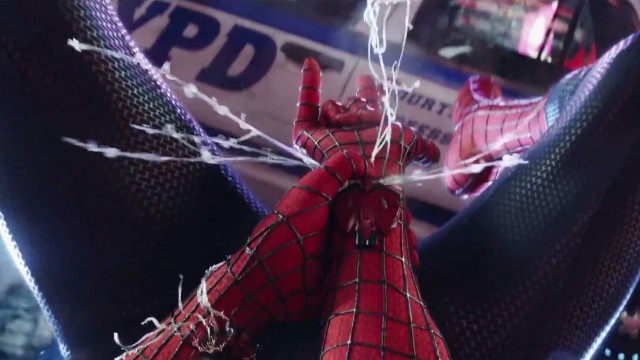8 Big Questions Left Unanswered By ‘The Amazing Spider-Man 2’

Sony Pictures
As it turns out, The Amazing Spider-Man 2 is not a very logical movie. It’s not like all of it is untethered from a general notion of reality, but it’s left us with some gaps in our understanding. Burning, unanswered questions that will most likely never make sense.
Granted, it’s no Oblivion (which we should all forget), but Marc Webb has left us a handful of things to scratch our head over.
Spoilers for the movie abound, so if you’ve already seen or plain just don’t care, feel comfortable in proceeding.
1. Why Does Harry’s Illness Progress So Damned Quickly?
In the first movie, if you can remember (you can’t, right?), a major plot catalyst was Dr. Curt Conners’ need to find a cure for the unseen Norman Osborn, who was off dying of a mysterious illness despite having billions of dollars at his disposable. You can’t take it with you. Memento Mori.
This time around, Norman (played by Chris Cooper) gets a bedside exposition-fest with son Harry (Dane DeHaan), telling him for the first time (?) that he has a genetically handed-down disease. Like magic, mentioning the existence of the disease causes it to rapidly rot Harry like an apple left out in the sun.
Even though his father is Chris Cooper’s age (62), Harry gets hit hard by the disease and deteriorates so rapidly that it drives him insane looking for a quick cure (Spider-Man blood!).
Understanding that diseases can affect different people in different ways and at different rates, what was going on here?
“By the way, you’ve got an illness that could kill you within the month even though I survived six decades with it. Goodbye forever, son.”
Side question: even with as estranged as they are, is it anywhere near possible that Harry didn’t know his father had been dying for years and years and years?
2. And why was it so bright in there?
This is a nitpick, but Colm Feore’s CEO Man character is sure to warn Harry before going in to see his father that the room is dark, but his eyes will adjust. It was one of those small, yet oddly specific notes that makes you think we’re in for a bit of a shock. Then he walked in, and…it was a well-lit room. Not at all dark. (Maybe our eyes adjusted quickly?)
Best guess? It was a throwaway bit of dialogue that didn’t make it’s way into the gaffer’s notebook.
3. What was Electro’s Dunk Tank Used for Originally?
A confused, suddenly-powerful being wanders into Times Square and starts Hulk Smashing everything in sight. Spider-Man further agitates him, but fortunately he’s subdued and safely taken to…a containment unit perfect for controlling his unique powers. Powers that no one had until about five minutes ago.
How did they build a jail cell for him at Ravencroft so quickly?
They couldn’t have, so the only answer is that it already existed in the facility. For pool parties, probably.
Side question: how tedious would living in a superworld be, when you have to develop that many different jail cell designs? Good thing they didn’t have to transfer Magneto to Ravencroft or anything.
4. Why did a Taser jolt set Electro free?
Speaking of which, if they were pumping him full of electricity to test him, why did the spark from a standard-issue Taser turn him into Dr. Manhattan?
5. Why would Gwen work at the very place that birthed a monster that killed her father and tried to kill her?
If you remember from the first film (you don’t, right?), Oscorp is greatly responsible for the birth of The Lizard, which means they’re at least partially responsible for the death of Captain Stacy.
Thus, this question is more or less a rhetorical way of saying, PTSD be damned, Gwen Stacy has guts.
Honestly, if Taco Bell killed your dad, would you go work there?
6. Why does Harry want to form a supervillain club again?
Setting aside that the ending was a bit of a blur that should have been saved for the next movie’s first act, this is the part that makes zero sense. Yes, Harry feels betrayed by an old friend (who he’s only recently reconnected with), but what does that have to do with building a gang of robotic suit-wearing baddies? It’s unclear why that’s the go-to move after killing your new nemesis’ girlfriend.
7. Will minor characters remain minor, or grow into supervillains soon?
Sinister Six is a thing that’s happening. At least Sony is trying to make it happen, which means we’ll soon have a lot of bad guys on screen. Meanwhile, The Amazing Spider-Man 2 introduced a few supervillains who haven’t earned their maniacal laughs yet.
- Felicity Jones played “Felicia,” also known as Black Cat (a kind of proto-Cat Woman)
- B.J. Novak played “Alistair Smythe,” who eventually becomes Ultimate Spider-Slayer
- Michael Massee plays “Mr. Fiers,” who is also called The Gentleman and has the superpower of being wealthy
- Also, probably someone on the plane that’s saved at the end becomes a supervillain, because why not?
8. What Would Have Happened if Spider-Man Had Remember Max’s Name?
Seriously. New sidekick?
Side question: Why do all the villains in Spider-Man’s universe have to be born directly because of their relationship with Peter Parker?
